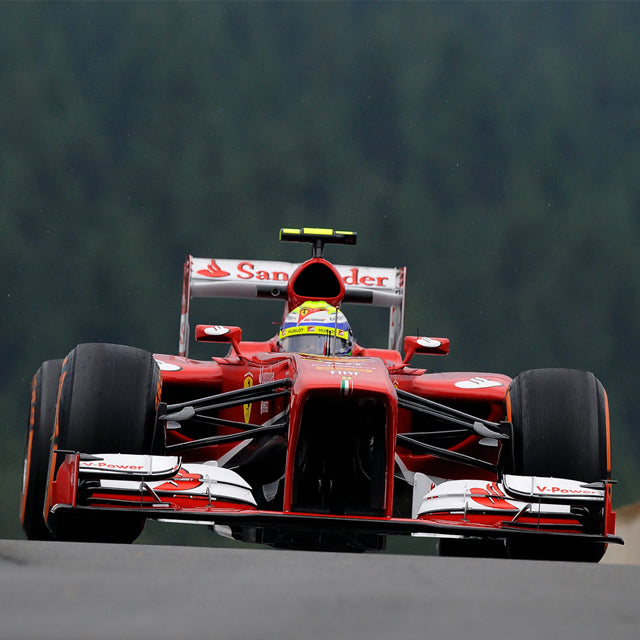Photography Courtesy of Ferrari North America
In a recent interview, Ferrari chairman Mr. Luca di Montezemolo, frustrated by recent Formula One rule changes, said he would consider pulling La Scuderia Ferrari out of Formula One, and return to sports car racing. The FIA's new regulations attempt to reduce costs and make F1 more environmentally friendly and have thus introduced a new hybrid V6 engine, which is quieter, more fuel efficient, and less polluting. Montezemolo says these and other restrictions detract from the Grand Prix experience, stating “No one wants to watch a driver save gas or tires. They want to see them push from here to there. It's sport, yes, but also a show.” With driver Fernando Alonso dropping the flag at this year’s recent 24 Hours of Le Mans, Ferrari may be eyeing a return to sports-car racing, but why did it quit in the first place?
Ferrari won the 24 Hours of Le Mans nine times. It also contested the Manufacturer's Championship for Sports Cars and Prototypes, then a crown jewel of the sport alongside Formula One, and between 1953 and 1967, it won 12 of those years. However, in 1974 founder Enzo Ferrari packed it in, and chose to concentrate exclusively on Formula One. So it wasn’t lack of success. Much like the grumblings now coming from Maranello about the state of Formula One, history has a funny way of repeating itself, and there is evidence that a similar confluence of affairs, taken together, caused La Scuderia to focus exclusively on Formula One from 1974 onwards.



First, racing is an enormously expensive venture and Enzo always quipped that he was manufacturing road cars only so he could pay for his real love, racing. The cost of racing on two fronts was so expensive in fact that it caused Ferrari to sell part of his company to Fiat in 1969. The agreement with Fiat left him in full control over Scuderia Ferrari, however, and also gave him access to Fiat's resources. But it wasn't Fiat's control of the purse strings that caused Ferrari to abandon sports car racing, as much as other factors.
Advancements in racing technology was causing costs to escalate further and a huge gap between sports cars and open-wheel cars began to open. Toward the end of the 1960s, street cars that could be raced on the weekend were no longer competitive. No manufacturer could build a road car and expect it to win races such as Le Mans, Daytona, or Sebring again, as they had in the past. So Ferrari's move to a dedicated race car program makes some sense.
Rule changes, much like the ones causing Maranello grief today, also played a role. Enzo had his battles with the folks at the FIA over several issues, however two stand out. The first was due to Ferrari trying to homologate his 250 GTO and 250 LM cars into the sports car category, probably an overreach on Ferrari’s own part, but the FIA insisted that a minimum of one hundred cars must be produced in order to homologate it. Enzo had neither the resources nor the intention at the time of producing the required number of cars so he withdrew from Formula World Championship series in 1964. However, as a workaround, he entered them as the NART Formula team, and won both the Drivers' and Constructors' Championship with Mr. John Surtees driving.



Eventually, the FIA acquiesced to homologation but the cars were now obsolete, and a bad taste was left in Ferrari’s mouth. In 1972 the Prototype and Group 5 Sports Car classes were both replaced by a new Group 5 Sports Car class. Previously, cars running in these classes could run with no upper limit on displacement, and gave birth to some of the most memorable cars and racing–the Ford GT40, Lola T70, Alfa Romeo 33, Porsche 917, Ferrari 330 P4, and 512S. However, with the new rules, these cars were limited to 3 liter engines by the FIA, a move that some believed was a French ploy to benefit their native Matra so that it might be competitive at Le Mans. The ploy worked, but most of the manufacturers, including Ferrari, quit. Arguably the life went out of sports car racing at that time.
So, the more things change, the more things stay the same. With the exception of a few successful sports cars they have built for privateers over the intervening years, Ferrari have not participated officially in sports car or endurance racing for decades. But cars such as the late 1970's 512 BB/LM, the 333 SP which won the IMSA World Sports Car Championship and IMSA GT Championship in the 1990s, the F430 GT2 and GT3 that won the ALMS and FIA GT championships more recently in their respective classes, and now an effort behind the current 458 Italia (in both GT2 and GT3) prove that Ferrari is still competitive today. "We cannot do sports-car racing and Formula One," says di Montezemolo. "It's not possible." There are more than a few car and motor racing enthusiasts who would like to see that change, and the Cavallino rampante return to sports car racing grids.





























































